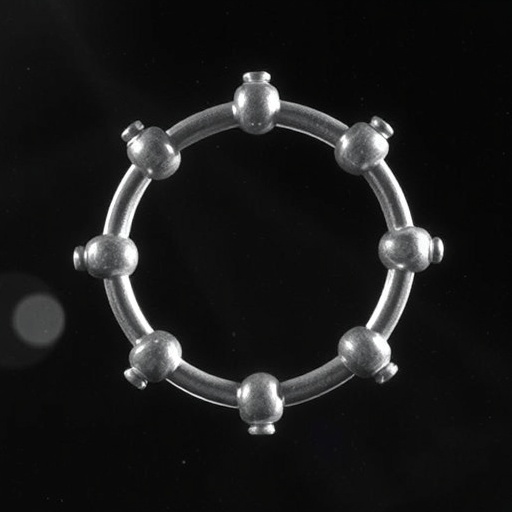In the dynamic field of nanotechnology and electrochemistry, a recent breakthrough has emerged that could significantly enhance the identification and detection of dihydroxybenzene isomers, a crucial aspect of various chemical analyses. Researchers Achar, Bhat, and Sajankila have developed a silver-doped zirconium copper oxide nanohybrid that showcases remarkable properties for electrochemical sensing. The innovative approach behind this research not only provides insights into the structural nuances of these isomers but also paves the way for advancements in analytical chemistry and material science.
The study centers around the need for efficient sensors that can reliably distinguish between dihydroxybenzene isomers. These compounds, which include ortho-, meta-, and para-dihydroxybenzene, are significant in various industrial applications and biological systems. Their presence must be accurately identified to ensure quality control and compliance with environmental safety regulations. Conventional methods have their limitations, often requiring time-consuming processes and complex instrumentation. Therefore, the development of a more efficient electrochemical sensor is crucial.
Utilizing nanohybrids has become a popular trend in the detection of organic compounds due to their enhanced surface area and unique electronic properties. The silver-doped zirconium copper oxide nanohybrid stands out in this regard, combining the benefits of each constituent material. Zirconium oxide is known for its excellent stability and mechanical strength, while copper oxide exhibits promising electrochemical properties. The incorporation of silver not only increases conductivity but also enhances catalytic activity, thereby improving the sensor’s sensitivity toward the target molecules.
The research team employed a sophisticated synthesis method to create the silver-doped zirconium copper oxide nanohybrid. This involved careful control of the doping process, wherein specific amounts of silver were introduced into the zirconium and copper oxide matrix. The resulting nanohybrid was characterized by a range of analytical techniques to ensure the desired properties were achieved. Scanning electron microscopy (SEM), X-ray diffraction (XRD), and energy-dispersive X-ray spectroscopy (EDX) were among the tools used to analyze the morphology, crystalline structure, and elemental composition of the nanohybrid.
Electrochemical characterization was pivotal in demonstrating the potential of the developed sensor. The nanohybrid exhibited exceptional electrocatalytic activity, which is essential for facilitating the redox reactions involved in the detection of dihydroxybenzene isomers. Cyclic voltammetry (CV) tests revealed that the silver-doped zirconium copper oxide nanohybrid provided distinct voltammetric profiles for each isomer, enabling their effective differentiation. The sensor’s ability to operate in diverse pH conditions further underscores its versatility and applicability.
In practical terms, the implementation of this electrochemical sensor could revolutionize the monitoring of dihydroxybenzene isomers in real-world scenarios. For instance, environmental applications may include tracking the levels of these compounds in wastewater or industrial effluents, where the contamination could have detrimental effects on ecosystems. Additionally, in the pharmaceutical industry, ensuring the purity of substances containing dihydroxybenzene isomers can be critical for product safety.
The potential for this sensor extends even further, as the principles of its design can be adapted for detecting other organic compounds. By modifying the composition of the nanohybrid or the operational parameters, researchers could explore its efficacy in other analytical scenarios, broadening its utility in various fields including food safety, clinical diagnostics, and environmental monitoring.
Innovation in materials science also facilitates the integration of such electrochemical sensors into portable devices. The miniaturization of sensors allows them to be used in the field rather than requiring samples to be sent to a laboratory for analysis. This capability can dramatically decrease response times and enhance the responsiveness of industries reliant on real-time data.
Moreover, the development aligns with the global push towards sustainable practices. By utilizing nanohybrid materials and focusing on electrochemical methods, which often require less hazardous reagents compared to traditional methods, the research supports a greener approach to chemical analysis. This paradigm shift highlights the importance of developing technology that is not only effective but also mindful of environmental impacts.
The insights gained from this study emphasize the role of interdisciplinary collaboration in advancing scientific knowledge. The convergence of chemistry, materials science, and engineering has led to innovative solutions capable of addressing contemporary challenges. As researchers continue to explore nanomaterials, it is anticipated that even more groundbreaking discoveries will emerge, pushing the boundaries of electrochemical sensing technologies.
In summary, the work done by Achar and colleagues signifies a remarkable leap forward in the field of analytical chemistry. The silver-doped zirconium copper oxide nanohybrid shows great promise in the electrochemical identification of dihydroxybenzene isomers. As research progresses and technology continues to evolve, the implications of this work are expected to resonate across multiple sectors, catalyzing advancements and applications that support the ever-growing demand for precise chemical analysis.
As the scientific community eagerly anticipates further developments stemming from this research, it becomes clear that the intersection of nanotechnology and electrochemistry has the potential to not only enhance our understanding of chemical substances but also improve public health, environmental safety, and industrial practices.
The commitment to innovation in this area suggests that the future holds even more creative solutions, positioning such research at the forefront of modern analytical chemistry.
Subject of Research: Electrochemical identification of dihydroxybenzene isomers using silver-doped zirconium copper oxide nanohybrid.
Article Title: Silver-doped zirconium copper oxide nanohybrid for electrochemical identification of dihydroxybenzene isomers.
Article References:
Achar, S., Bhat, R.S., Sajankila, S.P. et al. Silver-doped zirconium copper oxide nanohybrid for electrochemical identification of dihydroxybenzene isomers.
Ionics (2025). https://doi.org/10.1007/s11581-025-06633-2
Image Credits: AI Generated
DOI: https://doi.org/10.1007/s11581-025-06633-2
Keywords: Electrochemical sensing, nanohybrid materials, dihydroxybenzene isomers, zirconium copper oxide, silver doping, environmental monitoring, innovative materials science.




